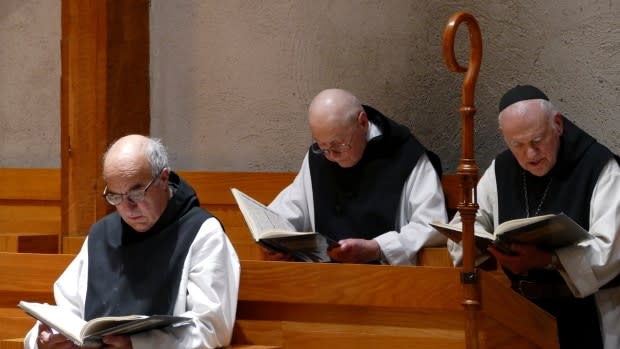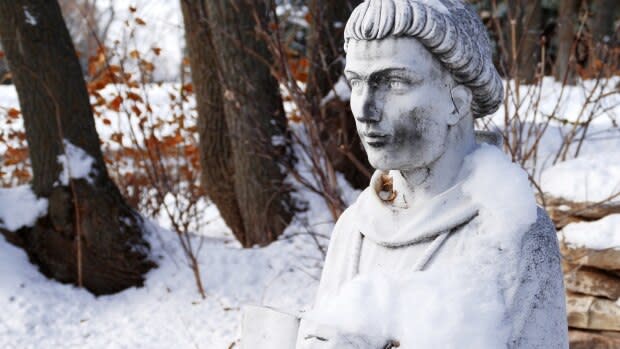Manitoba Trappist monastery, the last in Western Canada, for sale
The last Trappist monastery in western Canada is up for sale, ending a tradition dating back to 1892.
The Notre Dame des Prairies monastic community has been home to more than 400 monks over the past 128 years, including 42 years in its current location in Holland, Man.
Soon, however, its halls will empty, as the last Trappist monks in the Prairies leave the building for good.
"There are only six monks left. Four are in a long-term care home," said Father André Barbeau, father abbot of the Val Notre-Dame Abbey in Quebec and designated father of Notre Dame des Prairies. He spoke to Radio-Canada in an interview conducted in French.
"The youngest brother is 82 years old, and the oldest 95. They themselves made the decision to end their community."
The Cistercian Order of Strict Observance, also called the Trappist order, has already sold roughly 324 hectares of agricultural land surrounding the monastery — about 130 kilometres west of Winnipeg — to farmers, Father André said.
The two remaining monks will soon live in a house in Notre-Dame-de-Lourdes, he added, roughly 20 kilometres east of the monastery.

The buildings of the monastery, valued somewhere between $1.5 and $6 million, and 32 hectares of adjacent land are now on the market. The Trappist order is in negotiations with the St. Mark Coptic Orthodox Church, Father André said, and he hopes a deal could be finalized by late fall.
"They have several monks in Egypt and they are ready to bring more to Manitoba," he said. "They would like to use the monastery site as a spirituality centre, in collaboration with the archdiocese of St. Boniface."
Monastery 'never really took off' in Manitoba
The first Trappists arrived in Canada in 1881, and the order grew to 100 monks within the decade, Father André said. The Notre Dame des Prairies monastery was founded in 1892 in St. Norbert, after the parish priest, Father Joseph-Noël Ritchot, worked to have land set aside for its construction, according to a City of Winnipeg document.
It later became famous for its Trappist-style cheese, which was made there until 2018, when the last of the monastery's cheese-making monks retired.
But, Father André says, "it never really took off."
Looking back, Father André believes maintaining the use of French in the monastery may not have served it well. The monastery was francophone until the 1990s, when it became bilingual.

"It worked well at first, but in the 1940s, after the war, we realized that [the English language was becoming more and more important even within the archdiocese of St. Boniface]," he said
"In the '90s, maybe we should have chosen English as our only language. A lot of people who wanted to enter the monastic life were English speakers from Western Canada."
Many of those unilingual monks had difficulty adapting to the bilingual monastery.
"None persevered," Father André said.
"Twice, we sent a strong contingent of a dozen of monks each to try to revive the monastic life. A monastery in the United States also lent a hand by sending a group of nine brothers," he said.
"All this has not been enough to allow the community to flourish."
The last Trappist monks in the Prairies
The sale will mark the end of the Trappist presence on the Prairies, but traces of their order will remain, like the 77 tombs of the monastery's cemetery.
The cemetery will be repatriated to the cemetery of the parish of St. Norbert, Father André said.
"We never leave a cemetery behind us," he said.
"It is complicated and costly, but I think it is important. There will be, at least in St. Norbert, still the presence of the deceased."

The Trappist archives will also live on in Winnipeg. The order sent its entire collection to the St. Boniface Historical Society.
"We will contribute, including financially, to the development of this collection, because these archives are of interest to everyone," Father André said. "We would also like to have digitized copies."
A three-metre statue of the Virgin Mary and Child Jesus in her arms, currently located inside the monastery, will be offered to the Archdiocese of St. Boniface to be installed in the park alongside the Archbishop's residence.
All that the monks leave behind — the statue, cemetery and monastery itself, along with the ruins of the old monastery in St. Norbert — will be the last public traces of the Trappist order that spent more than a century contributing to Manitoba history.
An earlier version of this story was published in French by Radio-Canada. Click here to read the French version.


